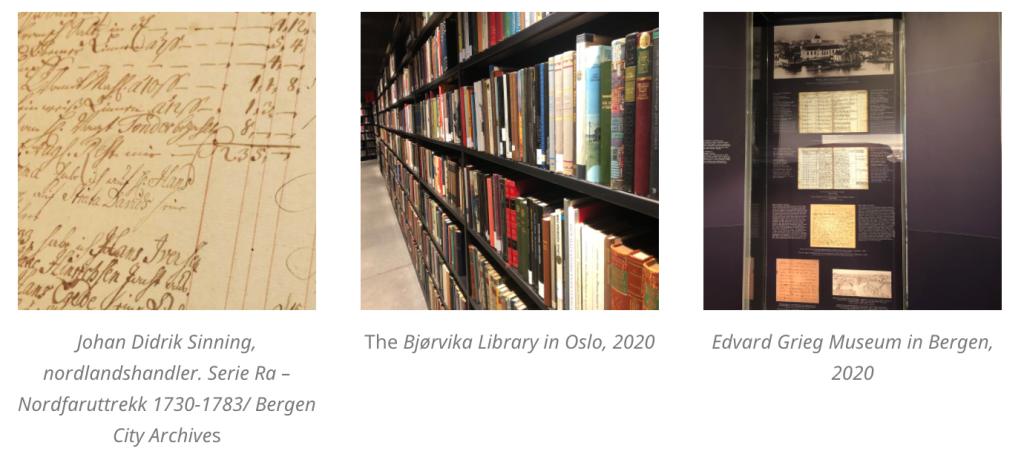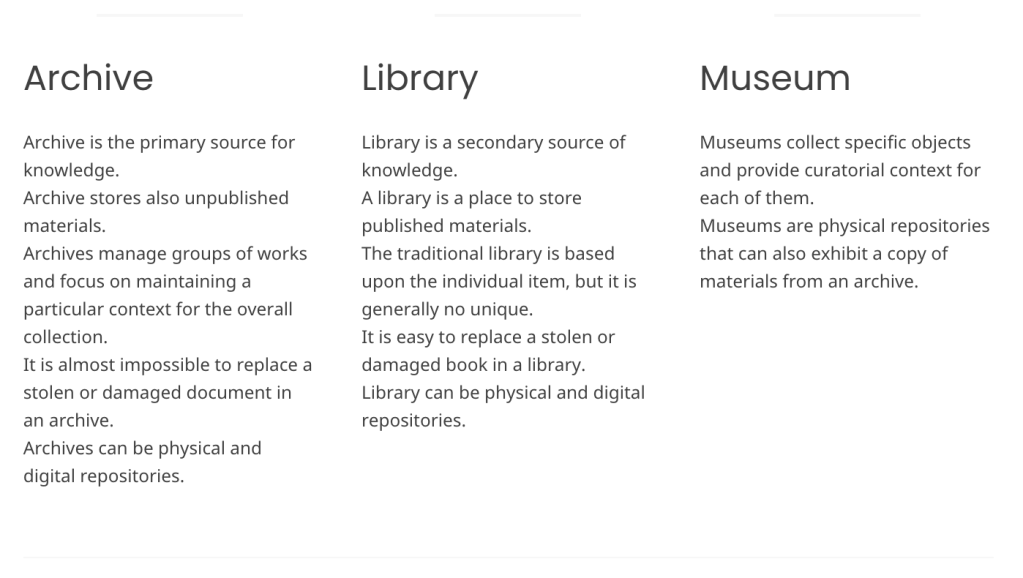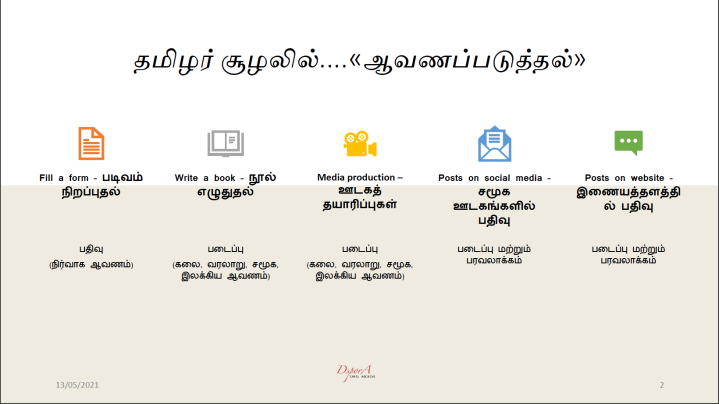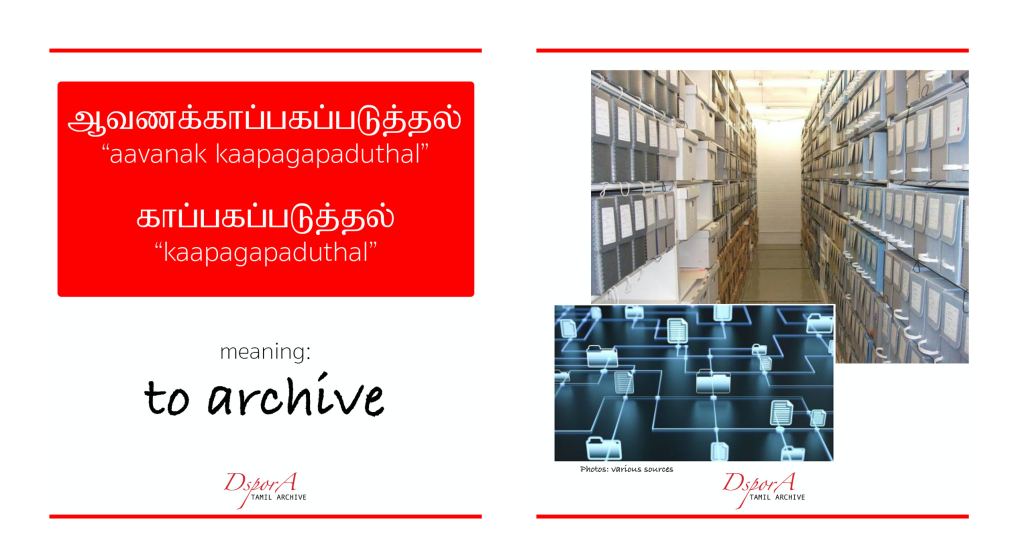By Nalayini Indran and Baheerathy Kumarendiran
It is fundamental to define the terms we use to make our process and practice meaningful and focused to gain our goal. When a term is undefined, it will confuse and diffuse our activities. Here we are trying to explain a few Tamil vocabularies related to documentation and archive.
A meaning of a word will depend on the geographical location, social structure, history and tradition of a society. A meaning of a word will also evolve. The search for Tamil vocabularies for documentation, archive and preservation-related activities will thereby be an ongoing and dynamic process. Please note that we are in an ongoing process to find the right Tamil words for each activity and stage in the life cycle of a record.
Records management and archiving for long term preservation is not new for Tamils. It has been happening, as known so far, since the Sangam Era. But it has been weakened by hundreds of years of colonisation, invasion, war, migration and genocide. Tamil society needs to gain back the ancient Tamil tradition of complete records management and archiving for long term preservation.
In the meantime, it is interesting to note that the desire to preserve documents is strengthening amongst Tamils, including the Tamil diaspora community; and methods to do so are taking new forms and methods. Alongside maintaining traditional efforts to preserve and archive historical documentation, Tamil communities across the globe are building and using more digital repositories such as libraries and archives. They use various digital media and platform for archiving, preserving and disseminating their documents of rights, history and heritage.
International Archives Day
International Archives Day [1] is an initiative of the International Council on Archives. Since libraries, museums and other archives do also have archives for long term preservation, they can celebrate the day of International Archives Day. Here, the term “archives” is given an inclusive meaning in the context and refers to both institutions and documentation.
We wish our Happy International Archives Day to all Tamil volunteers, staffs and activists worldwide in the field of archives, libraries and museums; and to everyone who work to document, archive and preserve the Tamil heritage. Evidence of the existence of Tamils is passed down through the generations by your work.


Archival institutions: archive, library and museum
- Archives have the primary function to receive, store, manage and make archives available for access and use.
- Some libraries have a secondary function to receive, store, manage and make archives available for access and use.
- Some museums have a secondary function to receive, store, manage and make archives available for access and use.
The coordination and sharing of responsibility between these three archival institutions can vary from country to country. How is this for Tamils?
Terminologies
The Tamil word “ஆவணப்படுத்தல்” (aavanap paduthal) is used diversely for the activity of documentation and transferring history to the next generation. The process of documenting and transferring rights, history and heritage involves many phases and activities. But the term “ஆவணப்படுத்தல்” (aavanap paduthal) is not only generalised in Tamil but also cause a lot of confusion continuously.
The lifecycle of records is as followed:


Archive
The English word “Archive” and the Norwegian word “Arkiv” have four meanings. The context around the use of this term can differ its meaning [2]:
- an archival document – காப்பக ஆவணம்
- the room where archives are kept ஆவணக்காப்பக அறை
- the function in business activity/ organisational activity that performs archive tasks; archive service – ஆவணக்காப்பகச் சேவை
- a body that receives archives from various organisations, stores, manages and makes them available for use; an archive institution – ஆவணகம்/ ஆவணக்காப்பகம்
Based on various ancient Tamil literature [3] the term «ஆவணம்» (aavanam) means market, bazaar (கடைவீதி), street (தெரு), right to property, ownership (உரிமை). It also means slavery, bondage, service (அடிமைத்தனம்); bond, deed (உரிமைப்பத்திரம்) and document
The English term archive can refer to both institution and document. According to Tamil dictionaries “archive” is called சுவடிக்கூடம் (cuvatik koodam), பொது ஆவணக்களரி (pothu aavanak kalary), ஆவணக் காப்பகம் (aavanak kaapakam) (institution); and பொதுப்பத்திரங்கள் (pothup pathiram) (document).
சுவடி (cuvati) means ola book (ஏட்டுப் புத்தகம்); book in general (புத்தகங்கள்); file, bundle, as of records (கோவையாக அமைத்த பத்திரத்தொகுதி). சுவடி (cuvati) derives from சுவடு (cuvatu) that has much meaning such as track, footstep (அடித்தடம்); Impression; Sign, indication (அடையாளம்). This word refers to பதிவு (pathivu) in sense of imprint, like footprint (கால் சுவடு) and handprint (கைச் சுவடு). Cuvatu gives historical traces. When adding a prefix to சுவடி (cuvati), we get the word ஓலைச்சுவடி (oolaich cuvati), which means imprint on oola, palm leaf (ஓலையில் பதிவு).
Record/ document – பதிவுகள்/ பதிவேடுகள்
“Ei logisk avgrensa informasjonsmengd som er lagra på eit medium for seinare lesing, lyding, framsyning eller overføring.” (Norwegian archive law)[4]. A logically delimited amount of information stored on a medium for later reading, listening, previewing or transmission (English translation).
A record/ document can be in a digital or analogue medium. It can be text-based, audio-based, video-based, multimedia-based medium. It can also be an object or artefact.
A record can be analogue or digital-born. Many archives do also digitize their analogue collections to protect records from regular handling to provide access. Digitization is creating digital copies of records that originated in traditional physical formats (analogue) such as paper, parchment, photographs, film, sound or video.
Appraisal – மதிப்பீடு/ தெரிவு
All the created and collected records need to appraised before sending them to long-term archiving and preservation. An appraisal is an activity of assessing and selecting records that have value for long-term preservation. The assessment will be based on the value as evidence, rights document of individuals or a society, historical value, cultural value or value as a source for research purposes.
Archival document – சுவடிக்கூடம் சார் ஆவணம்/ காப்பகம் சார் ஆவணம்
Documents that have value for long-term preservation. Records or documents that are created as «by-product of human activity retained for their long-term value» are called archives [5]. Such records/ documents become documentation of an event, action, decision, process or activity. Then after an appraisal process, certain records/ documents with long term value are archived as archival documents for long term preservation.
Archives are different from the terms, records or documents. Archives are a collection of documents or records which have been selected for permanent preservation because of their “value as evidence or as a source for historical or other research”[6].
These records will have important and valuable information about the organisation or the involved people. In addition to this, they provide evidence of undertaken activities, which tells us contextual information about individuals and the institution. They also increase our sense of identity and understanding of cultures.
Documentation (process)
The English word “documentation” can relate to two different types: products and processes. “Documentation” (document) in archive science is “product documentation”. It is the material that results from a transaction process. This is the product/ material that documents a transaction that has taken place. It provides facts and evidence. “Process documentation”, on the other hand, relates to all the activities and materials created during a transaction process.
Documentation– ஆவணம் (product, பொருள்)
Documentation– ஆவணப்படுத்தல் (process, செயல்பாடு)
To document – ஆவணப்படுத்தல் (process, செயல்பாடு)
Archive (institution)
A place where collections of documents or records have been selected and kept for permanent preservation. These collections are preserved in the archives (institution). Private archives and collections are also kept in the National Archives.
Archives (archival documents) are also kept by other institutions, including museums and libraries. These are also kept in other places such as universities, business, charities, community groups, religious organisations and local studies and archives.
In Tamil, words such as சுவடிகள் (suvadihal) (documentation) or சுவடிகள் கூடம் (suvadikal koodam) (Institution), களஞ்சியங்கள் (kazhanchiyam) (institution) were also used to describe “Archives” (institution and documentation). During the 1980s and 90s, the Sri Lankan Department of National Archives used the word “தேசிய சுவடிகள் திணைக்களம்” to describe Archives (institution). This has more recently evolved into the word “தேசிய சுவடிகள் காப்பக திணைக்களம்”.
To archive – ஆவணக்காப்பகப்படுத்தல்
National Archives
National Archives is home to millions of historical documents, known as records that were created and collected by central government departments and major courts of law.
Private Archives
Non-public / non-governmental organisations, religious organisations and individuals can hold private archives. These archives contain archives and collections of individuals and private companies.
Community Archives
The definition of Community Archives is the cause of some debate.
- The subject matter of the collection is a community of people.
A classic example is a group of people who live in the same location, but there are ‘communities of interest’ as well, such as people who worked in a certain profession. - The process of creating the collection has involved with the community.
Typically, this means that volunteers have played a key role, sometimes alongside professional archivists. [7]
«ஆவணப்படுத்தல்» – to do documentation
The Tamil word «ஆவணப்படுத்தல்» (aavanap padhuthal) is being widely used to refer to the activity of documenting, protecting and/ or transferring history and knowledge. But which activity does this word refer to? And which activity do Tamils label as «ஆவணப்படுத்தல்».
The word «ஆவணப்படுத்தல்», in Tamil context, is used for the activities to write an article, book, other text-based publications or audio-visual media production. The word is used to refer to the activity of documenting something to place it in history. The mentioned products are published materials.

These published materials, like administrative records and unpublished materials, are created as a result of the functional activities of a person or an organisation. Nowadays, a radio channel might create a digital audio file of news sending as a result of its function. A Tamil Sangam might create an anniversary booklet as a result of its function. A political or humanitarian organisation might organise a demonstration as a result of its function. The demonstration might be documented as photos or video recordings. Or the organisation might distribute leaflets at the demonstration. These might be published and unpublished materials, which would have been created followed by many unpublished administrative records, such as meeting minutes and other planning documents. But what happens with these published and unpublished materials in the Tamil environment?
The first part of the life cycle of a record is the “records management” (பதிவேட்டு முகாமை) (see figure 2 and 3). This period involves the phase of trigger for a process, creation of a record, collection of documentation, transaction, index, classification and appraisal. This period happens locally in the organisation where a transaction takes place. The «ஆவணப்படுத்தல்» (avanap padutal) comes in this period. It can refer to the activity of documenting a transaction. This is the activity of making documentation of a transaction that has taken place.
In the Tamil environment, the life cycle of a record stops at the creation or collection of documentation of a transaction in an organisation. The activities such as indexing and classification for retrieval are lacking or not happening. Over time, the documents are neither archived within the organisation nor at an archive. This leads to archival documents being dumped in a storeroom or basement. The archival materials get fragmented, damaged or lost.
«ஆவணக்காப்பகப்படுத்தல்» – to archive
Documents with “value as evidence or as a source for historical or other research” need to be archived. Archiving with a retrieval system protects rights, history and heritage. It will allow us to transfer the knowledge to generations to come. The term “archiving” in Tamil is “ஆவணக்காப்பகப்படுத்தல்”. “ஆவணக்காப்பகப்படுத்தல்” (archiving) has a duty of indexing, cataloguing, describing archives and preservation for retrieval, dissemination and use. This is archive management. An archive service in an organisation will do the first period of archiving.
When the records/ documents become inactive for administrative purposes, they will be given to an archival institution for long-term preservation. Archival institutions could be an archive, library or museum.

Need of a combined function of documentation and archiving
Many types of records and information among Tamils are now being created or “born digitally” including emails, word-processed documents, spreadsheets, digital photographs, video and websites. These need to be documented, classified, appraised, managed and stored properly, so they can be retrieved and used for future purposes. It is also important to take data security measures.
There is a social need of an integrated function between records management and archive management for long term preservation of Tamil heritage. This is to protect and transfer documentation of rights, history, knowledge and heritage of this society. To meet this need, we humbly request all Tamil organisations to appoint a records manager in their organisation and trigger the life cycle of records. Archival institutions should join hands with the society and organisations to complete this need and transfer Tamil heritage for generations.
பின்குறிப்பு மற்றும் மேற்கோள்கள்
[1] International Archives Day
ICA. (n.a.-a). About International Archives Day and International Archives Week. Retrieved from https://www.ica.org/en/about-international-archives-day-and-international-archives-week (Access, 05.05.2021)
[2] “Archive” and “Arkiv”
ICA. (n.a.-b). What are archives? Retrieved from https://www.ica.org/en/what-archive (Access, 16.05.2021)
King´s College Cambridge. (n.a.). 1. What are Archives? Retrieved from https://www.kings.cam.ac.uk/archive-centre/introduction-to-archives/a/1 (Access, 06.06.2021)
Store Norske Leksikon. (03.06.2021). arkiv. Retrieved from https://snl.no/arkiv (Access, 05.05.2021)
The National Archives. (n.a.). What are archives? Retrieved from https://www.nationalarchives.gov.uk/help-with-your-research/start-here/what-are-archives/ (Access, 05.06.2021)
[3] Terminologies: ஆவணம் (aavanam), சுவடு (cuvatu), சுவடி (cuvati) and archive
தமிழ் இணையக் கல்விக்கழகம் – Tamil Virtual Academy. (n.a.-a). TVU – Tamil Lexicon- தேடுதல். Retrieved from http://www.tamilvu.org/ta/library-lexicon-html-lexhome-161876 (Access, 08.06.2021)
தமிழ் இணையக் கல்விக்கழகம் – Tamil Virtual Academy. (n.a.-b). கலைச்சொற்கள். Retrieved from http://www.tamilvu.org/ta/library-technical-glossary-html-index-116547 (Access, 08.06.2021)
தமிழ் இணையக் கல்விக்கழகம் – Tamil Virtual Academy. (n.a.-c). சென்னைப் பல்கலைக்கழக ஆங்கிலம் – தமிழ் அகராதி. Retrieved from http://www.tamilvu.org/ta/library-pmdictionary-html-madsind-161994 (Access, 08.06.2021)
தமிழ் இணையக் கல்விக்கழகம் – Tamil Virtual Academy. (n.a.-d). சென்னைப் பல்கலைக்கழக தமிழ்ப் பேரகராதி. Retrieved from http://www.tamilvu.org/ta/library-lexicon-html-srchlxpg-161884 (Access, 08.06.2021)
[4] Norwegian Archive Law
Arkivlova. (1999). Lov om arkiv. Retrieved from https://lovdata.no/dokument/NL/lov/1992-12-04-126 (Access, 16.05.2021)
[5] Archival Document
ICA. (n.a.-b). What are archives? Retrieved from https://www.ica.org/en/what-archive (Access, 10.05.2021)
[6] Evidence
The National Archives. (2016). Archive Principles and Practice:an introduction to archives for non-archivists. Retrieved from https://www.nationalarchives.gov.uk/documents/archives/archive-principles-and-practice-an-introduction-to-archives-for-non-archivists.pdf (Access, 01.06.2021)
[7] Community Archive
Latimer, J. (2006). What is a community archive? Retrieved from https://www.communityarchives.org.uk/content/about/what-is-a-community-archive (Access, 08.06.2021)

